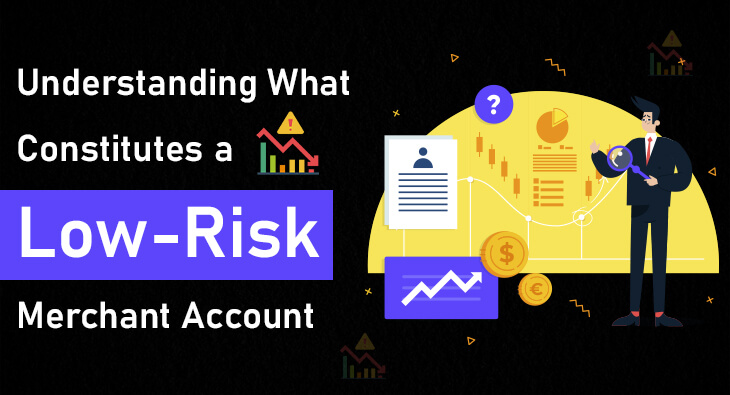As businesses move increasingly towards digital payments, understanding the concept of a merchant account is critical. These accounts, a requirement for businesses to accept debit or credit card transactions, can be categorized into low-risk, medium-risk, or high-risk. But what exactly constitutes a low-risk merchant account? This blog post aims to demystify this concept and provide insights into its benefits and how to secure one.
Demystifying the Concept of a Low-Risk Merchant Account
A low-risk merchant account, in the realm of payment processing, is associated with businesses that present a minimal level of danger to the payment service provider. How does one determine this level of risk? It’s evaluated on various parameters like the business’s nature, credit history, transaction history, and industry type.
For example, if you own a business that operates within a stable industry, you maintain a low chargeback ratio, and your credit history is impeccable, then your business is generally perceived as low-risk. This, in turn, makes you eligible for a low-risk merchant account.
Some Related Blogs
- The Ultimate Guide to High-Risk Payment Gateway for BigCommerce
- Deciphering Recurring Billing: A Comprehensive Guide
- Simplifying Transactions: The Benefits of E-Payment for High Risk Merchants
- Unpacking PCI Level 1 Compliance: What You Need to Know
Contrasting Low-Risk and High-Risk Merchant Accounts
In the world of payment processing, the distinction between low-risk and high-risk merchant accounts is primarily drawn based on the perceived level of danger a business presents to payment processors. Businesses with high-risk accounts are typically considered more volatile due to factors like higher chargeback rates, unpredictable market conditions, and unfavorable credit histories.
These risks associated with high-risk accounts often translate into higher transaction processing fees, lengthier settlement periods, and in some cases, the necessity for cash reserves. These requirements can create financial burdens and operational challenges for businesses.
Contrastingly, low-risk merchant accounts are linked with businesses that operate in stable industries, have an excellent credit history, and a low chargeback ratio. These businesses are viewed favorably by payment processors due to their reduced risk factor.
This favourable outlook provides significant benefits to low-risk businesses. They typically enjoy lower transaction fees, faster access to processed funds, and they operate under fewer restrictions. It’s this contrast in conditions that highlights the importance for businesses to strive towards achieving and maintaining a low-risk merchant account status.
Therefore, understanding the dichotomy between low-risk and high-risk merchant accounts is crucial for businesses aiming to optimize their payment processing experience. It helps them strategize better and steer their operations towards a more favourable financial and operational landscape.
Unveiling the Benefits of a Low-Risk Merchant Account
The privileges of holding a low-risk merchant account extend far beyond mere convenience. Most noticeably. These accounts are linked with reduced transaction fees. The diminished risk they pose to payment processors translates into savings, making it financially beneficial for businesses.

Another advantage is the speed at which funds become available. Unlike their high-risk counterparts. Low-risk merchant accounts often enjoy expedited settlement periods. This means quicker access to your funds, facilitating improved cash flow and financial planning.
Furthermore, the stability associated with a low-risk merchant account can serve as a negotiation tool. Businesses with a low-risk classification have a better footing to negotiate favorable terms with payment processors. This ability to secure better conditions can prove to be a game-changer. Potentially leading to significant cost savings and operational efficiencies over time.
In addition, the minimized disruptions associated with low-risk merchant accounts allow for seamless business operations. With less concern for payment processing issues, businesses can focus more on their core operations and customer service, leading to better overall performance.
Lastly, a low-risk merchant account can contribute to a positive business reputation. The perceived stability and reliability that come with this status can enhance your business’s credibility in the eyes of consumers, payment processors, and potential investors. It’s a ripple effect – a low-risk merchant account can lead to operational smoothness, which in turn leads to improved customer satisfaction and trust.
Steps to Securing a Low-Risk Merchant Account
To attain a low-risk merchant account, certain strategic steps can guide you towards this financial advantage. First, fostering a healthy credit history is vital. Regularly paying your bills and responsibly handling your debts can enhance your credit profile and demonstrate financial stability to payment processors.
Another key aspect is maintaining a minimal chargeback ratio. To achieve this, prioritize superior customer service, transparent refund policies, and consistent product or service quality. These elements not only reduce the chances of chargebacks but also build a solid reputation for your business.
![]()
Email us anytime!
Email customer service 24/7
![]()
Call us anytime!
Reach customer care 24/7 at +1 (727) 330-3944
Operating within an industry known for its stability can enhance your chances of acquiring a low-risk status. This might not always be within your control but being aware of your industry’s standing can help you anticipate and manage risk factors better.
Additionally, establishing a consistent and sound transaction history can paint a positive picture of your business’s reliability and stability. Regular, trouble-free transactions over a considerable period can bolster your application for a low-risk merchant account.
Lastly, partnering with a trustworthy payment processor can be a significant advantage. An experienced processor can provide valuable guidance during your application process and offer insights to optimize your business for lower risk. In conclusion, acquiring a low-risk merchant account may require some effort and strategic planning. But the benefits it offers can substantially outweigh the initial investment of time and resources.


